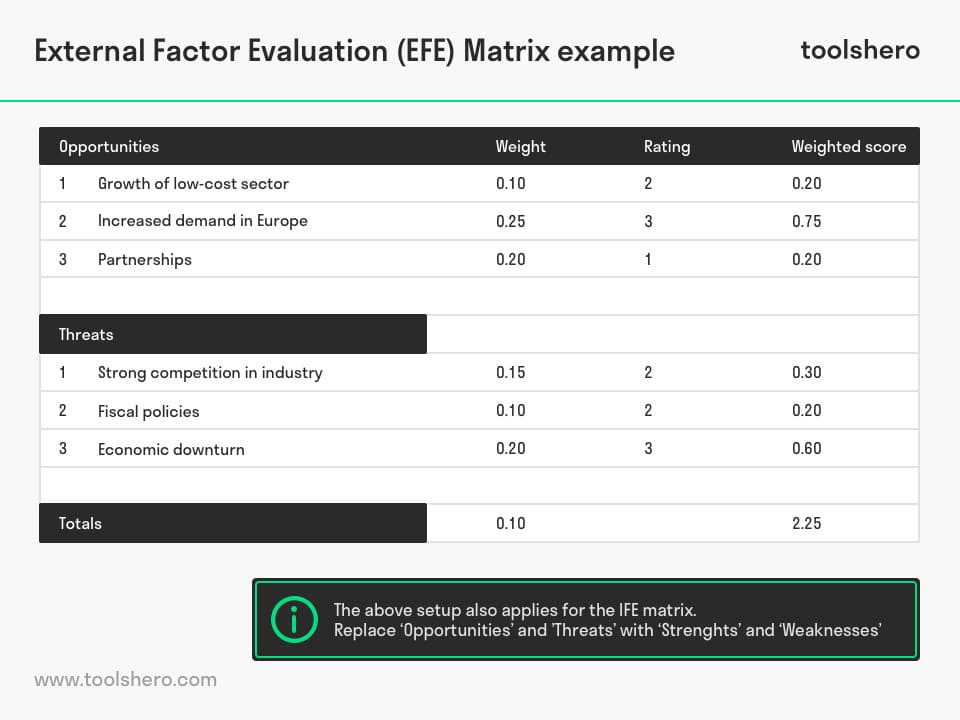EFE Matrix / IFE Matrix explained

EFE matrix: this article explains the EFE matrix and the IFE matrix in a practical way. Next to what this matrix is, the article also highlights the external and internal factors, the weights, a step-by-step plan and the advantages. After reading it, you understand the core of this strategy methodology. Enjoy reading!
About the EFE matrix and the IFE matrix
The EFE and IFE matrices are analysis methods that strongly resemble a SWOT analysis that represents an internal analysis (strength and weakness of an organisation) and external analysis (opportunities and threats of an organisation).
The letters EFE are an acronym for External Factor Evaluations, which shows how effectively the company’s current strategy responds to external opportunities and threats.
It’s viewed as a strategy tool that’s used to investigate a company’s external environment and to identify the available opportunities and threats.
It must always be combined with the IFE matrix, which stands for Internal Factor Evaluations. This strategy tool is used to evaluate the internal environment of companies and discover both the strengths and weaknesses.
The EFE matrix and IFE matrix were introduced by American strategic planning scholar and consultant Fred R. David in his book ‘Strategic Management‘ in 1997.
According to him, both tools can be used to gather information obtained from external and internal environmental analyses of companies. The summarised information can be evaluated and used for further purposes such as building a SWOT analysis.
EFE / IFE matrix: external and internal factors
The combination of the results of the EFE and IFE matrices can be used to evaluate the organisation’s strategy and the various strategic intentions. The best results of the added, weighted averages can be chosen to make new strategic decisions.
By means of the EFE matrix, the most important external opportunities and threats that may influence a company can be identified. In general, these data can be studied by, for instance, a PEST analysis, Porter’s Five Force Framework or a Competitive Profile Matrix.
The simplest way to gain information on the external environment is the PEST analysis; this model analyses the influence of Social, Technological, Economic and Political factors on macro level within the organisation.
Porter’s Five Forces Model is another useful tool, in which external influences, such as the power of suppliers and customers, the threat of substitute products and new entrants on the market, as well as the competition are studied more closely. A Competitive Profile Matrix (CPM) is an external strategic analysis companies can use to compare themselves to their competitors.
By means of the IFE matrix, strengths and weaknesses are used as the key internal factors in the evaluation of the organisation. In the search of internal strengths, companies can wonder what they’re good at and what yields added value for their customers compared to what their competitors offer.
What are the employees proud of and what is going well within the organisation? To uncover the weaknesses, companies can look at how they could improve themselves and their services and products. What is currently not going optimally, and what elements are more developed at their competition?
EFE / IFE matrix: weights
Each key factor within the EFE matrix and the IFE matrix must be weighted with a number ranging from low interest (0.0) to high interest (1.0). The number indicates how important the factor is when a company wishes to succeed in a specific industry.
Without assigning weight, all factors would be equally important. Individual factors mustn’t be emphasised too much, because the success in a sector is rarely determined by one or just a few factors. It’s important that the weights have the same meaning in both the EFE matrix and the IFE matrix.
Ratings
The general rule is to identify 10 to 20 key external factors, as well as 10 to 20 key internal factors. More factors is also an option. The meaning of the ratings differs per external (EFE) and internal (IFE) matrix.
The ratings of the EFE matrix refer to the effectiveness of a company’s current strategy and what this means for the external opportunities and threats. The ratings range from 1 to 4, where 1 is a poor rating, 2 an average, 3 an above average, and 4 a superior rating. The idea is that ratings are subjectively assigned to each factor.
The ratings in the IFE matrix refer to the strong and weak internal factors within a company. Here too, the ratings range from 1 to 4, where 1 and 2 are related to weakness and 3 and 4 are related to strength; 1 represents major weakness, 2 means minor weakness, 3 represents minor strength, 4 indicates major strength.

Figure 1 – an example of an EFE matrix / IFE matrix
Total Score
The eventual score is the result of the weighting, multiplied by the rating. It’s important that each key factor is assigned a score. The total weighted score is the sum of all individual weighted scores.
In both the EFE matrix and the IFE matrix, that same total score from 1 to 4 can arise. The total score of 2.5 is an average. The result of a low score in the external rating indicates that a company’s strategies aren’t properly set up to fully utilise the opportunities and protect against threats.
A low score for the internal rating indicates that the company is weaker compared to its competitors.
Steps
The following step-by-step plan can be helpful to guide the rating process of the EFE and IFE matrices:
Step 1
First, the most important external and internal factors must be identified. This can be done by means of the previously mentioned PEST analysis. This clarifies which factors currently affect the organisation.
This could concern opportunities or threats that could help or harm the organisation. In this phase, it’s also wise to analyse the actions and strategies of the competitors, for instance with Porter’s Five Forces Model.
Step 2
Now, the weightings and ratings must be subjectively assigned. Often, the weightings are assigned based on opinions and knowledge of the sector.
Step 3
By multiplying the weightings and ratings of each factors, a weighted total score is calculated. Both the EFE and IFE analyses must be combined, and this can lead to new strategies.
They can be used for building an advanced SWOT analysis, for instance. The total score rates the organisation’s internal position and the strategic intention.
Advantages of the EFE matrix & IFE matrix
Both matrices offer lots of advantages. For instance, they are easy to understand, and they don’t require extensive expertise, or investment in terms of time, money and employees.
The used factors serve as input and have a clear meaning for everyone inside and outside the organisation. They focus on the most important internal and external factors, and the result can be used for a multitude of functions, such as building a SWOT analysis or benchmarking.
Now it’s your turn
What do you think? Do you recognize the practical explanation of the EFE matrix and the IFE matrix or do your have any additions? Are you familiar with the use these analysis methods? Are there any tips you would like to share?
Share your experience and knowledge in the comments box below.
More information
- Capps III, C. J., & Glissmeyer, M. D. (2012). Extending the competitive profile matrix using internal factor evaluation and external factor evaluation matrix concepts. Journal of Applied Business Research, 28(5), 1059.
- Cassidy, C. M., Glissmeyer, M. D., & Capps III, C. J. (2013). Mapping an internal-external (IE) matrix using traditional and extended matrix concepts. Journal of Applied Business Research, 29(5), 1523.
- David, F. R. (2011). Strategic management: Concepts and cases. Peaeson/Prentice Hall.
How to cite this article:
Mulder, P. (2019). EFE / IFE matrix. Retrieved [insert date] from Toolshero: https://www.toolshero.com/strategy/efe-ife-matrix/
Original publication date: 05/08/2019 | Last update: 08/04/2023
Add a link to this page on your website:
<a href=”https://www.toolshero.com/strategy/efe-ife-matrix/”>Toolshero: EFE / IFE matrix</a>












